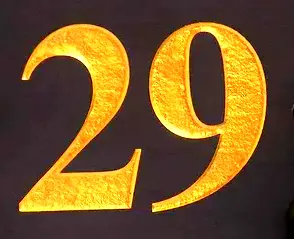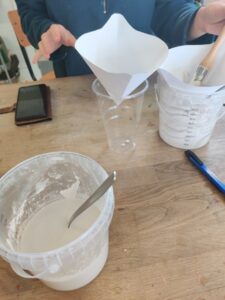Last month I was fortunate to go on a gold leafing course in Havant near Portsmouth on the south coast of England. Firstly, I cannot sing more highly the praises of the man teaching the class, Richard Walker. Apart from being a thoroughly nice person, he was incredibly generous with both his knowledge and his time.
So, why did I take myself off on this course? Well those who have been following me for a while may have noticed that I have been quietly and, so far, sparingly, introducing gold into my artwork.
I have bought all the equipment, watched a ton of videos on the university of Google and have had some success with what I have been doing. I am not unhappy with what I have achieved so far. But ever the potential perfectionist and having a very enquiring mind (call it nosey if you prefer), I wanted to understand how to do this properly.
So having watched videos on Google and Instagram what I now know I was seeing was water gilding. It looks so easy and maybe if you have had 25 years of practice like Richard has you can make it look easy, but it is not. Even he admits that it doesn’t always go to plan and occasionally, very occasionally, he must make changes or redo something which isn’t working. I will tell you a bit more about that in a moment.
So, having been asked about my experience of gilding and the others in the class describing what they know, we had to state what we hoped to get out of the class.
There were only four of us and one gentleman had only booked to do a day. He wanted to know how to gold leaf the recesses of the Welsh slate piece he had which has writing on – in Welsh – which had been chiselled out, leaving an indentation. The photos here give you an idea.

He was introduced to oil gilding and managed to paint all the different layers he needed to include, plus golf leaf the piece, all in one day. It looked amazing when done but he still had to finish it off and treat the slate in some way. I didn’t really understand that bit.
The two others on the course were: an artist/printmaker who wanted his artwork in gold leafed frames. The cost of having someone do this for you is huge so he wanted to do it himself; and a woman conservationist whose employer is sending her on a series of courses to increase her understanding and skills base. My own reasons were twofold. I wanted to use real gold in my artworks, and I wanted to learn how to attach real gold to my picture frames.
The gold I have been using to date isn’t actually real gold. Did you notice? Probably not: you have to understand the quality of products to be able to recognise the differences. The products I use are gold-coloured silver sheets, which are not cheap by any stretch of the imagination, but nowhere near as expensive as the 24 carat gold sheets we were using on the course.
Because of the pathway I am interested in following, I was fortunate to learn two different methods of gilding: oil gilding and water gilding. They are very different.
The water gilding is without doubt the hardest to learn and master but gives the most amazing, and lasting, results when done by an expert. Seriously, Tutankhamun’s outer sarcophagus was water gilded and remained in perfect condition hidden away in a tomb in the Valley of The Kings. His outer coffin was made of gilded wood, with three inner coffins; the final one being made of solid gold.
We were given a mitred corner, just as you would have in a picture frame.
We were shown how to make the rabbit skin glue, which is the first layer of the corner, then the gesso which goes over the rabbit skin layer and then a layer of bole (see below), which is what you gild onto. 
The gesso intrigued me as I use shop-bought gesso all the time for the first couple of layers on my canvases and wooden boards. Gesso is a kind of primer when used for paintings. Once dry, it gives a slight hardness to the surface and whilst filling in the gaps of a loose weave canvas, it also gives a texture for acrylic paint to adhere to. Most of the time I buy pre-gesso’ed canvases but still add a couple more layers myself.
If you simply used raw canvas without any gesso in it the paint would soak into and through the canvas, giving you a bit of a mess to deal with.
However, when water gilding the layers of gesso act in a different way. Firstly, the more layers you add the better. Why? Because once you have added at least eight layers but often a few more, you then need to start sanding it back to a beautifully smooth and polished surface. This was something I did not fully manage but it was incredible seeing what could be achieved by continual sanding. It looked like marble in places. The edges and corners of mine were not great. But, hey, it was my first time.
The bole is a super-refined clay, which apparently you can use as a cosmetic face mask as it contains all sorts of wonderful minerals. This product comes in many different colours, but the traditional colour is a red or terracotta, with black and yellow also being popular with traditional water gilders. It is to this layer that the gold leaf is applied using distilled or de-ionised water, neat gin or vodka or isopropyl alcohol (99% proof), water and a minuscule amount of gelatine.
And whilst it was frustrating that every time I leant over to pick up my gold sheets they tried to stick to my jacket, which contains nylon so created unwanted static, watching the gold cling to the water base on the frame was great fun.
I also got to do some oil gilding as this is what is best for use in my artworks. I am really excited by the results and intend to start using it more, when my supplies arrive, on both my finished artworks and on the frames I have. 
The question now is what do you think of the difference between gold colour silver sheet and 24 carat gold sheets? Clearly, the additional cost both in time and gold products will affect the price I charge for them, but I am super excited with the final look of my new works.
NB Just for the record, I do not get paid to endorse any of the brands I have mentioned above.
If you have enjoyed reading this post, please like and follow me and please share it with people who you think might be interested. I am always on the lookout for new artists to feature as I know how much everyone enjoys reading about other artists. Also, if you think there is a subject you would like to know more about and would like me to write about, I will be happy to consider it. Sharing, liking and following my blogs increases the number of people the algorithm shows the blogs to, so please share. Thank you in advance for supporting me this way.
